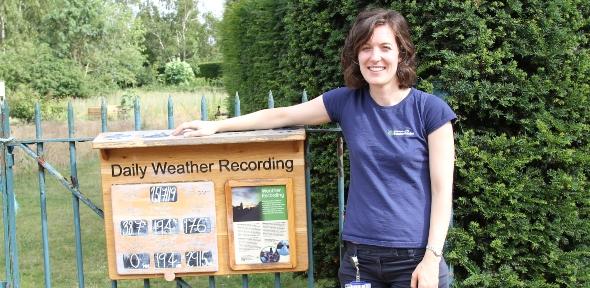
How has recording the UK's highest temperature affected the work and the members of staff at the University's Botanic Garden?
What is it like to make history and hit the news headlines as part of your Cambridge working day? Katie Martyr is a member of the horticultural team at Cambridge University’s Botanic Garden and, as weather officer, every morning completes weather checks and records the data for both the Botanic Garden and the Met Office.
On Thursday, 25 July 2019 Katie thought she and her colleagues might be in for some hot weather, but did not anticipate she would be recording the UK’s highest ever temperature. The Met Office visited the following Monday to check the equipment at the Botanic Garden against their own precision equipment and verified the accuracy of Katie’s readings.
“It’s great to have had the reading verified,” says Katie “and exciting to have taken the reading here in the Botanic Garden. But it reminds us what a huge issue climate change is, and gives us a salutary caution about what is happening to our environment.”
Every day for over 100 years, a member of staff at the Botanic Garden has taken manual daily weather readings of rainfall, air and ground temperature, relative humidity, wind speed and cloud cover are recorded at the weather station. All the details are written up in the Garden’s weather recording book and sent to the Met Office to support national weather records, and its long history of weather recording is very important to researchers analysing climate change. Katie has been working at the Botanic Garden for over two years. She took over weather duties from her colleague John Kapor who had taken the readings for 17 years, one of the roles he has had as part of his 39-year career at the Botanic Garden. John remembers a similar heatwave in August 2003 when he saw temperatures of around 36 degrees celsius, and he also remembers his coldest reading: -13.6 degrees celsius, in February 2012. They say that working in very cold weather is actually easier than working in the very high temperatures.
At the Botanic Garden on 25 July, glasshouses and ticket offices were closed due to the temperatures, visitors stuck to the shade rather than sunbathing and picnicking on the lawn as usual, and the horticultural team cooled down by putting their feet in buckets of water. The response to the highest temperature was not only focused on the people: the horticultural team had to change their strategies for managing the heat by watering earlier in the morning, and then braving the 45C temperatures in the glasshouses for a quick water later on in the day. And the long-term strategy for the Botanic Garden has to respond to the increasing temperatures and dryness too: Sally Petitt, Head of Horticulture, reports that the collection at the garden has been affected by climate change, and that there is concern that plants from temperate zones may not be able to continue to grow there. She says: “It is a struggle to know how to best evolve and extend the collection. We have recently planted a dry meadow with plants especially selected for the Cambridge climate, but as a living museum it is important that we are able to protect all of our plants.”
In the days that followed the highest temperature reading, the Botanic Garden experienced higher than normal visitor numbers, and they have left the board readings up, which have proved to be a popular photo opportunity for visitors. Those working there agree that once the buzz of taking the UK’s highest temperature has abated, the challenge of dealing with climate change and its impacts will remain.
